Editor's note: For more information on this innovative system, listen to our recent podcast featuring all three of the authors of this article.
When working offshore, having a safe and stable work and walking surface is critical for worker productivity and safety. However, due to offshore environmental extremes, equipment limitations, and coating constrictions, successful installation of a functional non-slip deck coating can be a challenging process.
This article details some of these challenges and how a coating applicator using an innovative new protective coatings pump design with a new single-coat carbon nanotube non-slip deck coat slurry, is overcoming these challenges; while at the same time providing offshore clients with a sustainable, quick turnaround option that reduces downtime, provides a corrosion-resistant non-slip surface, and returns areas back to the owner in 24 h.
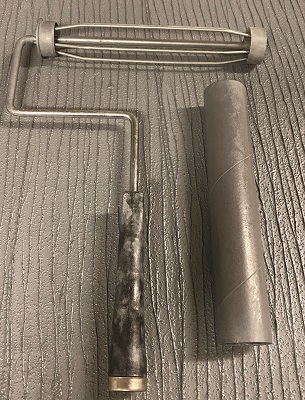 In the offshore environment, worker safety is always the top priority. According to the Maritime Industry Injury Guide,1 slip and fall accidents are one of the most common causes of injuries. To combat this risk, platforms must be equipped with safe, stable, non-slip deck coatings wherever workers are present.
In the offshore environment, worker safety is always the top priority. According to the Maritime Industry Injury Guide,1 slip and fall accidents are one of the most common causes of injuries. To combat this risk, platforms must be equipped with safe, stable, non-slip deck coatings wherever workers are present.
In general, the process of applying and maintaining these coatings has been challenging, given the ever-changing weather conditions and the resulting interruption to normal platform operations. This is because the traditional non-skid deck coating systems require the application of three separate layers (or more), which in turn requires extensive preparation and at least three days for full installation. During this time, the area(s) under treatment are inaccessible, requiring detailed advance planning to coordinate the coatings work with normal platform activities.
In an effort to help streamline the deck coating process, Danos approached Tesla NanoCoatings to develop a sustainable solution using its carbon nanotube (CNT) technology. The request was a challenging one as the defined goals were to include a solution that:
• Consisted of less application steps than the current traditional offerings of a multi-coat deck system.
• The ability to provide cathodic protection.
• And to produce a non-skid surface that did not involve broadcasting the aggregate into the wet coating.
The challenge was accepted, and the teams began diligently working on a proof of concept product. As the teams continued their research, it became increasingly apparent that the coating objectives (high build, one step, cathodic protection, and non-skid) had never been attempted by anyone and wasn’t achievable with traditional coatings technology. However, they developed a theory that if the CNTs could be functionalized with the epoxy resin to reinforce the composite material, then the addition of non-skid aggregate and sacrificial metal capable of achieving percolation of its electrons along a CNT quantum network, was theoretically viable.
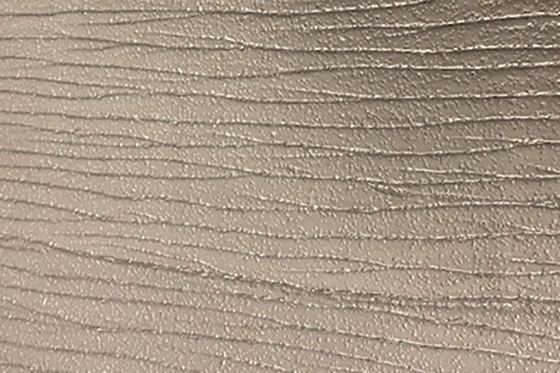
CNTs may be produced via a variety of methods such as chemical vapor deposition (CVD) or plasma arcing, and are formed from sheets of hexagonally bound carbon atoms.2
Chemical functionalization of CNTs refers to the covalent bonding of functional groups onto CNTs. It can occur at the endcaps of the CNTs or the sidewalls of the CNTs and results in the CNTs being inextricably bound to the composite resin matrix. The benefits include both enhanced physical and electrical properties of the composite matrix.3-6
The lab began working closely with their chief nano scientist on viable methods to develop a prototype material. Before the end of the year, the team had produced a high-build, single-coat/single-step, zinc-CNT aggregate filled epoxy composite coating, capable of return to service the next day.
The question now became one of “how does an applicator apply this first of its kind technology?” This is where the team jumped into action.
They quickly developed two manual application methods; a roller method capable of completing 10 to 12 ft2 (0.9 to 1 m2) per minute (Figure 1 and Figure 2), and a trowel application method capable of completing 6 to 8 ft2 (0.5 to 0.7 m2) per minute (Figure 3 and Figure 4). The team also realized early on that traditional spray equipment was not going to have the capabilities needed to apply this material and that they would need to employ some out of the box thinking to create a viable solution to the spray application dilemma.
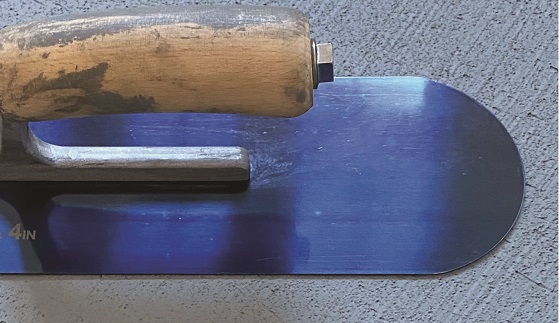
They decided that partnering with the industry spray equipment leader would be the best path forward and contacted Graco to begin discussions. Recognizing Graco’s commitment to leadership in quality and technology along with their more than 90 years’ experience in designing and manufacturing fluid handling equipment, they were confident that developing a viable spray solution was going to be possible.
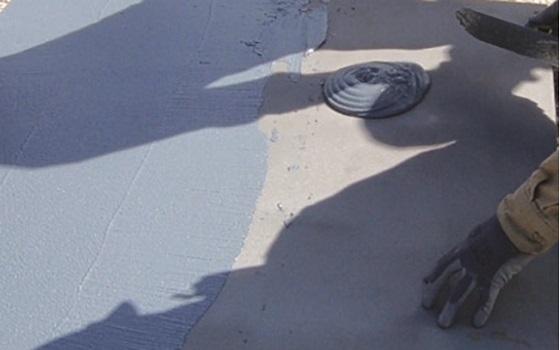
Since non-slip and non-skid deck coatings are engineered to withstand heavy traffic and harsher environments, these coatings can be difficult to spray and apply. They use a complex chemistry containing a coarse aggregate in order to give the coating the necessary non-skid characteristics, which in turn can cause issues with wear and tear on traditional protective coating spray equipment. The team began looking at a mortar pump as the pump lower was specially designed for use with materials that contain aggregate up to 4 mm in particle size (Figure 5).
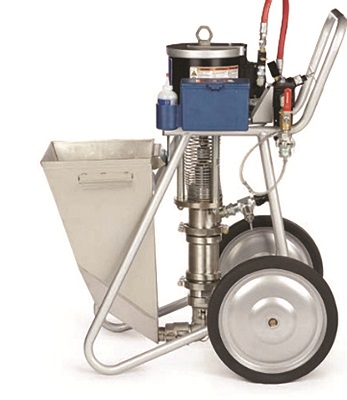 The team found that it was able to pump the new coating material and they next turned to optimizing the spray pattern to create a uniform non-skid finish. Different applicator tools were tested and the team was able to achieve the desired spray finish using the Graco HTX 680 Application Module† (Figure 6).
The team found that it was able to pump the new coating material and they next turned to optimizing the spray pattern to create a uniform non-skid finish. Different applicator tools were tested and the team was able to achieve the desired spray finish using the Graco HTX 680 Application Module† (Figure 6).
Another benefit to using this pump was that it shared many elements similar to other protective coatings two-ball pump airless sprayers. The pump proved to be very simple to operate for the applicators since they were already familiar with running a pneumatic pump, which resulted in a very shallow learning curve as the application techniques to apply the product was similar to standard airless spray techniques the team was already familiar with. This increase in productivity was quickly realized when the applicators were measured at applying the new coating at a rate of 20 ft2 (1.9 m2) per minute within 5 min of receiving applicator training (Figure 7).
 Downtime costs and installation times associated with installing non-slip coatings in marine and offshore environments are always hurdles to overcome. This pump’s features, like the quick knockdown pump lower, operation similar to traditional pneumatic protective coatings sprayers, and high-volume production, provided a quick and profitable way to spray and apply non-slip coatings containing aggregates.
Downtime costs and installation times associated with installing non-slip coatings in marine and offshore environments are always hurdles to overcome. This pump’s features, like the quick knockdown pump lower, operation similar to traditional pneumatic protective coatings sprayers, and high-volume production, provided a quick and profitable way to spray and apply non-slip coatings containing aggregates.
The coatings and safety experts’ relentless pursuit of better solutions to solve customer challenges resulted in proactively looking for new technology, materials, and equipment that can offer improved value for their clients. Through this ongoing effort, Danos has been able to identify a new nano non-skid coating material and delivery system that represents a major upgrade to traditional deck coating methods. They remain committed to providing asset owners with optimum corrosion solutions, increased productivity, and reduced downtimes, without compromising on safety over the asset’s lifetime.
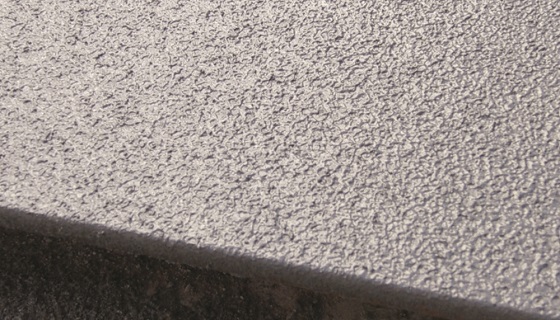
† Trade name
References
1 https://www.maritimeinjurycenter.com/accidents-and-injuries/slip-and-fall/
2 J. Davis, SSPC Coatings + Presentation, 2019.
3 Stanishevsky, et al., J. Achieve. Mater. Manuf. Eng. 37 (2009).
4 T. Hawkins, et al., Smart Coatings and Nanotechnology Applications in Coatings, Vol 5B (Novelty, OH: ASM, 2015).
5 S.U. Khan, J.R. Pothnis, J.-K. Kim, Effect of Carbon Nanotube Alignment on Electrical and Mechanical Properties of Epoxy Nanocomposites, Composites A, 49 (2013).
6 J.A. Virtanen, Composition for Corrosion Prevention, PCT/US2012/055389.